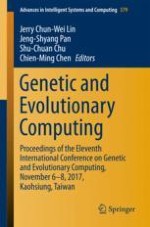2018 | Book
Genetic and Evolutionary Computing
Proceedings of the Eleventh International Conference on Genetic and Evolutionary Computing, November 6-8, 2017, Kaohsiung, Taiwan
Editors: Prof. Jerry Chun-Wei Lin, Prof. Jeng-Shyang Pan, Shu-Chuan Chu, Chien-Ming Chen
Publisher: Springer Singapore
Book Series : Advances in Intelligent Systems and Computing
